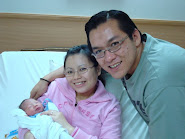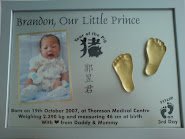- Chevonn is down with fever again since sat (5th June 10). TOday I brought her to Nam Seng clinic. Was given Nurofen, Paracetamol, Antibiotics and one medicine to bring down the heatiness inside her body.
- I reached at 8.30am, clinic registration starts at 9am and I got my queue 5th in line. Doctor only came in at 10am and I waited till 10.40am to see the doctor.
- She was diagnosed with Tonsillitis.
- Vomited twice after we reached home at 11.30am. Worried.
- Brought her back to clinic at 7pm.
- Given inserts for high fever and vomiting.
- rest are fluid medicine, only for anti-virus is tablet. .
What Is Tonsillitis? Tonsillitis is an infection of the tonsils. It is caused by either a virus or a bacterium (usually the bacterium known as streptococcus - the same bacterium that causes "strep throat"). Tonsillitis mostly occurs in young children. What Are Tonsils and Adenoids?  The tonsils are a pair of small almond-shaped organs located of the mouth on both sides of the throat. The adenoids are similar to the tonsils but are located in the upper portion of the throat behind the nose, where they can't be seen.  - At one time many doctors believed that tonsils had no real purpose and often routinely removed them to avoid tonsillitis. Today, tonsils and adenoids are seen as perhaps the "first line of defense" against disease-causing germs that enter the body through the nose, mouth, or throat.
- Tonsils and adenoids protect against germs during early childhood by producing antibodies
 . By attacking bacteria and viruses, antibodies play an important role in the body's immune system. The problem is that in the process of protecting the body, the tonsils and adenoids can become infected themselves. . By attacking bacteria and viruses, antibodies play an important role in the body's immune system. The problem is that in the process of protecting the body, the tonsils and adenoids can become infected themselves. - As children grow and develop, the tonsils and adenoids eventually begin to shrink and are probably no longer important in protecting against disease-causing germs. Even in young children, removal of infected tonsils or adenoids does not seem to weaken the body's defenses. There are many other tissues in the body that are part of the immune system. These tissues, known as lymphoid tissues , also make antibodies to fight against infection.
|
![]()
![]()
![]()
![]()





